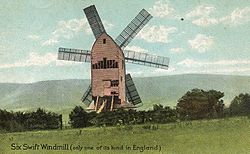Kingston near Lewes
| Kingston near Lewes | |
| Sussex | |
|---|---|
 Ashcombe Mill, Kingston | |
| Location | |
| Grid reference: | TQ394083 |
| Location: | 50°51’36"N, 0°1’12"W |
| Data | |
| Population: | 831 (2011) |
| Post town: | Lewes |
| Postcode: | BN7 |
| Dialling code: | 01273 |
| Local Government | |
| Council: | Lewes |
| Parliamentary constituency: |
Lewes |
Kingston near Lewes is a village in Sussex. The village is located two miles south of Lewes, nestled in the South Downs.
The village is mentioned in the Domesday Book.
Overview
The village is small and situated at the base of the South Downs. Features include the primary school, village hall, riding stables, and the local pub, The Juggs, which is housed in a 14th-century cottage. The pub and Juggs Lane (a road used as a public path which runs by it), are named after the fish-carrying baskets used by Brighton fishwives on their way through Kingston to the market at Lewes. The path may still be traversed by foot, but is unsuitable for vehicles (though legal for them), and continues to Woodingdean.
Many of the older houses are in the original village centre, "The Street", a picturesque mixture of cottages and larger farmhouses that leads past St Pancras Church and the village pound, where stray sheep were once kept, to the South Downs Way.
During the 1930s to 1950s, a number of substantial houses were built on Kingston Ridge and in the early 1960s orchard land was developed to form what is known locally as "the estate", family houses that helped serve the establishment of the University of Sussex at that time. During the construction of the estate, a new village green, St. Pancras Green, was built. It features tennis courts and a cricket ground, and in summer supports occasional rounds of the traditional Sussex game of stoolball. The radical reputation of the university influx earned this new green the nickname "Red Square" from some of the more traditional locals.
The Greenwich Meridian passes to the east of Kingston near Lewes.
About the village
The Norman parish church, St Pancras, has a distinctive Tapsel gate, with a central pivot which locals believe was designed to make it easy for funeral bearers to pass either side.[1][2]
Above Kingston, to the east of the village, stood Ashcombe Mill, a six-sailed post mill which collapsed in 1916. Planning permission was granted for the construction of a replica of the mill for residential purposes on the original site,[3] which has since been built
Westward of the village the land rises to a height of over 600 feet at Kingston Hill and Newmarket Hill.[4]
Outside links
| ("Wikimedia Commons" has material about Kingston near Lewes) |
References
- ↑ Roberts, William J. (1950). "Tapsel: His gate". Sussex County Magazine. Archived from the original on 27 April 2007. https://web.archive.org/web/20070427215629/http://scm.pastfinders.org/scm_24_tapsel.htm. Retrieved 21 September 2008.
- ↑ John Houghton (2000), The Parish Church of St. Pancras. Kingston-Near-Lewes, Kingston Parochial Church Council
- ↑ "Kingston, Near Lewes". Sussex Mills Group. http://www.sussexmillsgroup.org.uk/ashcombe.htm. Retrieved 18 October 2008.
- ↑ A History of the County of Sussex - Volume 7 pp 57-60: Parishes, Kingston near Lewes (Victoria County History)

